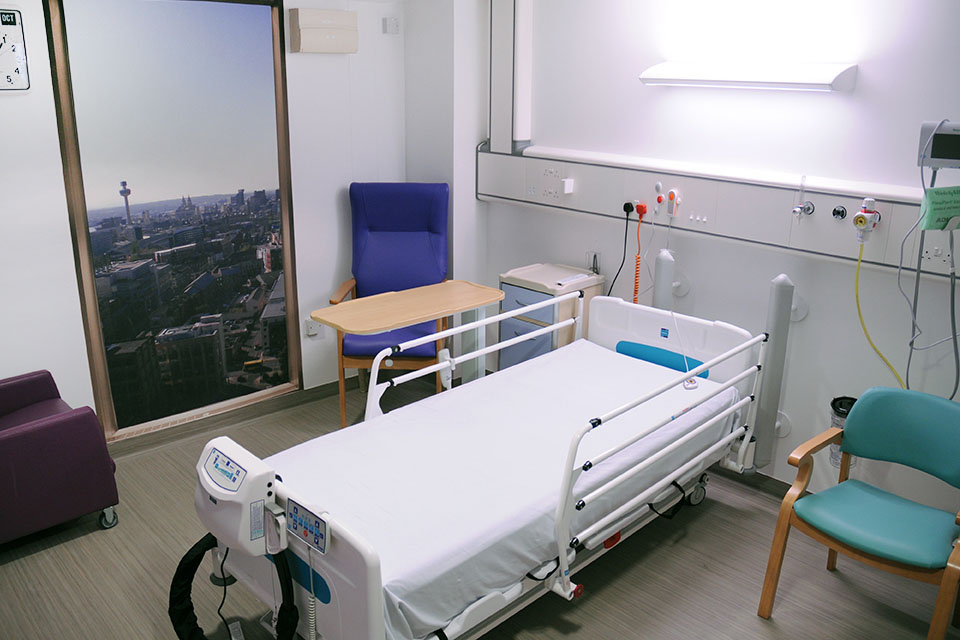NEW HOSPITAL CAMPAIGNERS ATTACK RUSHED AND FLAWED DECISION

Patient safety concerns take second place to obsession with Watford Hospital
Hospital campaigners, including DHAG have criticised local health bodies who yesterday (1st October, 2020) decided to ignore the case for a new convenient central modern hospital to serve everyone in West Hertfordshire.
The New Hospital Campaign (NHC) described the decision to spend over half a billion pounds on refurbishment and new build at Vicarage Road Watford as rushed and based on flawed, shaky and often misleading evidence.
Flying in the face of expert analysis and their own massaged survey which revealed public and NHS staff disquiet about their plans, West Herts Hospital Trust (WHHT) and Herts Valley Clinical Commissioning Group (HVCCG) today produced a shortlist including SIX Watford options and none for anywhere else in West Herts.
Key to the decision was timing – the Government wants a new hospital in West Herts by 2025 or 2026. Meeting jointly, the two health bodies claimed on flimsy evidence that new central greenfield sites would take much longer to build on than new facilities at Watford.
A spokesperson for New Hospital Campaign commented on this point:
'Yet a report led by West Herts’ own partner Trust, the Royal Free, showed that a new greenfield hospital could be built just as quickly. All the timings were close to each other. '
Once again, the views and needs of local residents have been ignored and this decision will come back to haunt those that made it.
The full press released from New Hospital Campaign can be read here .
TRUST’S SURVEY ‘WIDE OPEN TO MANIPULATION’ SAY CAMPAIGNERS

West Herts Hospitals NHS Trust (WHHT) finally produced a public survey in September asking local residents to give their views on hospital services.
The survey was rushed out and unfairly favoured development at the Vicarage Road site of Watford General Hospital. It was inaccurate in relation to the review of other sites that the Trust had previously commissioned. The New Hospital Campaign noted the following flaws along with others:
- The survey fails to provide the public with genuine options - it was published the same day as the draft shortlist which only includes Vicarage Road options;
- Was hastily put on the Trust website and gave respondents just 11 days to complete it;
- It was wide open to manipulation because the online form can be filled in multiple times by the same person at the same computer;
- It contained leading questions encouraging the public to support options at Vicarage Road
Furthermore, the CEO of WHHT urged readers in the Watford Observer to complete the survey but her letter did not appear in equivalent newspapers covering Dacorum and St. Albans District.
Twice before we have had petitions reaching over 10,000 signatures for a new hospital on a clear central site and there are many active groups online that share the same view. But the Trust and Herts Valleys CCG have consistently side-lined it.
In summary, the data collected from this survey should not be presented as an accurate representation of public opinion.
Click here for the full press release
Click here for the NHC paper on '9 Major Flaws'
CAMPAIGNERS CAST DOUBT ON FUTURE HOSPITAL SITE SURVEY

Campaigners for a new hospital have raised serious doubts about a review of possible sites for hospital redevelopment in West Herts. The review, called a Site Feasibility Study, has been
commissioned by the West Herts Hospital Trust (WHHT) and is being used in the selection of a shortlist of sites for the project, due to be decided on 1 October.
However, the New Hospital Campaign (a joint campaign between DHAG, Berkhamsted and St. Albans Campaigners) are concerned that the study is led by a company wholly owned by Royal Free London Trust, which has a close and increasing working relationship with West Herts Trust. Therefore, campaigners are concerned that this is not an independent study at all and is weighted in favour of the trust and not local residents.
For example, a study of one site at Watford General is rated as highly suitable for re-development, despite there being a large sewer that runs underneath the site and notes that suggest there is a likely risk of contamination once work starts.
This example and others are good reasons why a new build on a clear central site would be far better value for money for local residents. The trust believe that re-development could be completed by 2025, but NHC's buildings expert team think this is unrealistic compared with the option of a new hospital on a clear site.
The full study commissioned by WHHT can be read at the link below, followed by a link to our technical appraisal of the study by a very experienced construction specialist, questions about the independence of the study and our full press release.
We asking members of the public who would be interested and can be involved in fighting against these decisions that we believe are not in the public interest, to please get in touch via the Contact Us form with any information you may have.
NHC Questions on Independence of Study
CAMPAIGNERS CAST DOUBT ON FUTURE HOSPITAL SITE REVIEW

Campaigners for a new hospital have raised serious doubts about a review of possible sites for hospital redevelopment in West Herts. The review, called a Site Feasibility Study, has been
commissioned by the West Herts Hospital Trust (WHHT) and is being used in the selection of a shortlist of sites for the project, due to be decided on 1 October.
However, the New Hospital Campaign (a joint campaign between DHAG, Berkhamsted and St. Albans Campaigners) are concerned that the study is led by a company wholly owned by Royal Free London Trust, which has a close and increasing working relationship with West Herts Trust. Therefore, campaigners are concerned that this is not an independent study at all and is weighted in favour of the trust and not local residents.
For example, a study of one site at Watford General is rated as highly suitable for re-development, despite there being a large sewer that runs underneath the site and notes that suggest there is a likely risk of contamination once work starts.
This example and others are good reasons why a new build on a clear central site would be far better value for money for local residents. The trust believe that re-development could be completed by 2025, but NHC's buildings expert team think this is unrealistic compared with the option of a new hospital on a clear site.
The full study commissioned by WHHT can be read at the link below, followed by a link to our technical appraisal of the study by a very experienced construction specialist, questions about the independence of the study and our full press release.
We asking members of the public who would be interested and can be involved in fighting against these decisions that we believe are not in the public interest, to please get in touch via the Contact Us form with any information you may have.
NHC Questions on Independence of Study
FIGHT FOR THE TRUTH CONTINUES AS TRUST'S ENGAGEMENT BRANDED A FARCE

The New Hospital Campaign (NHC) has succeeded in obtaining a crucial
letter about hospital redevelopment in West Herts which the West Herts
Hospitals Trust (WHHT) has received from the Department of Health and
Social Care (DHSC).
The letter has been referred to at recent stakeholder meetings which the public have been invited to, however this letter has never been produced until it was disclosed to NHC's solicitors as part of the ongoing judicial review.
The letter seems to instruct West Herts Hospital Trust to only present 3 options to be considered for much needed hospital investment, all of which focus on Watford being the main site for A&E. This despite 2 petitions signed by tens of thousands of residents saying they want a new hospital built on a more accessible site.
The full press release from NHC can be read below along with the damning letter in full from the Department of Health and Social Care.
Letter to WHHT from Department of Health RE: Watford Hospital
WHY WE NEED A NEW A+E HOSPITAL TO SHIELD US FROM FURTHER VIRUS OUTBREAKS

With the high number of deaths in hospitals from COVID-19 we must prepare for likely further virus outbreaks and put a high priority on effective infection control. New Hospital Campaign (NHC) member Jean Ritchie has looked at the research about how the provision of single rooms promotes this.
She quotes one study as concluding “Single room isolation facilities are essential in acute hospitals and will become increasingly important as highly transmissible and increasingly resistant organisms colonise and infect patients”. A leading expert says “There is a consensus view in Europe and North America that single rooms in hospitals are important in preventing and controlling healthcare associated infections”.
From her review Jean says single rooms not only eliminate the risk of cross-infection but also, by putting sinks near the entrance to the room, underline the importance of hand-washing for all staff “which is not easy on a ward where washing facilities are shared”.
We can only have enough single rooms in a newly built hospital on a clear site, not an old one where only around half of the estate is to be renovated as the West Herts Hospitals Trust (WHHT) has proposed. So far the WHHT have made no provision at all in their redevelopment plans for more single rooms. Building anew will save lives.
This is one of the reasons why members of the NHC have congratulated the Princess Alexandra Hospital Trust (PAHT) in Harlow, Essex, just 30 miles away and in the same planning area as West Herts, on reportedly being given a conditional offer of £600million to build a brand new hospital on a clear site, which is their preferred way forward. Like the West Herts Hospitals Trust (WHHT), the PAHT were one of the first six trusts that the prime minister announced last September would get funding to build a new hospital. But as mentioned above the WHHT’s plan so far has not been to build a new hospital at all, only to redevelop parts of the decaying and inaccessible Watford General Hospital.
WHHT, which covers a much larger population than PAHT and has a substantially larger annual turnover, hasn't told us if it has received a similar or higher conditional offer - and if not, why they think no such offer has been made.
The NHC believes only a new hospital on a clear, central site can safely meet the emergency and specialist health needs of the West Herts population in the years to come, and WHHT must give this option full and fair consideration, which hasn’t happened up to now. After the experience of COVID-19 we cannot afford to get this investment in our futures wrong – lives will depend on it.
Editor’s Note:
- Jean Ritchie’s article about single rooms is attached separately.
- For details of the offer to the Princess Alexandra Trust, see here.
THE CASE FOR SINGLE HOSPITAL ROOMS IN INFECTION CONTROL

With the assumption that the NHS will face further virus outbreaks, perhaps not as severe as COVID-19 but nonetheless a severe strain on resources, the need for effective infection control within hospitals should be a major priority in the future redevelopment or building of new hospitals.
A study of the impact on infections of the move from an old hospital to a new building, with a high proportion of single rooms (Brunel Building, Southmead Hospital, North Bristol Hospital Trust), published in 2017, showed that the number of bed days lost to norovirus was “significantly lower. Increased availability of single rooms had an impact on the transmission of highly contagious norovirus infection, [which is] dispersed via the airborne route.”
The study concluded: “Single room isolation facilities are essential in acute hospitals and will become increasingly important as highly transmissible and increasingly resistant organisms colonise and infect patients…. There was a significant reduction in the bed-days lost and ward closures due to norovirus infection.” (i)
An earlier study by King’s College, London, was carried out into single rooms at Tunbridge Wells Hospital in Pembury, Kent (opened in 2011). The hospital was the first in England to contain only single-bed rooms, and replaced a Victorian hospital and former workhouse. The researchers examined the experience of patients and staff both before and after the move. They looked at an admissions ward, a surgical ward, an older people’s ward and a post-natal ward.
Patients reported more privacy, dignity and confidentiality in single rooms. They felt the privacy enabled them to disclose to medical staff and relatives more sensitive information. They slept better and no longer had the indignity of using toilets within the earshot of others.
The downside was that immediately after the move to the new hospital, there was an increased incidence of older patients falling. But within nine months this had been remedied, as nursing staff became more familiar with the new routines of working with single rooms, and as the disturbance of the move for older patients had receded.
Two thirds of all patients preferred single rooms, with older patients (over 80) being the ones who most preferred to be in wards with other patients. (ii)
Another advantage of single rooms was highlighted by Professor Hugh Pennington, a leading microbiologist based at Aberdeen University, and a firm advocate of the single bed system.
“There is a consensus view in Europe and North America that single rooms in hospitals are important in preventing and controlling healthcare associated infections……..Single rooms facilitate family involvement in patient care and increase the opportunities for treatment at the bedside. They enable better bed management, abolish gender bed blocking (when a patient cannot be admitted to an empty bed because the others in the shared accommodation are of the opposite sex) [our italics] and lead to fewer patient transfers.
“…..The evidence that physical barriers are good at preventing the spread of microbes is strong. A recent study in Canada on the effect of changing intensive care unit arrangements from multibed to single rooms showed falls in rates of acquisition of clostridium difficile of 43% and staphylococcus aureus of 47%.”
These reduced infection rates resulted in a 10% reduction in the length of time patients needed to stay in hospital. (iii)
Professor Pennington’s views were echoed in an article in the Journal of Clinical Microbiology and Infection, which concluded:
“Single bed occupancy reduces air-borne as well as cross-transmission of pathogens between patients…..Scientific evidence should lead to an increase in the number of single rooms in hospitals in such numbers that all contagious patients can benefit.” (iv)
Research has mainly concentrated on nosocomial infections (hospital-acquired infections like MRSA and C-diff), as well as hospital-acquired influenza (HAI). A 2016 European study compared double-occupancy rooms (not common in Britain) with single rooms, and concluded:
‘We observed higher HAI risk among patients hospitalised in double-occupancy rooms than those in single-occupancy rooms. In addition to being more appropriate for global patient care regarding privacy, rest, familial support, cost and confidentiality, single occupancy rooms are reducing the risk of hospital-acquired infections, including influenza.” (v)
The design of single bed rooms not only eliminates the risk of cross-infection between patients, but also, with the provision of sinks near the entrance to the room, underlines the need for scrupulous handwashing by all staff (which we have all learned during the pandemic is a key to controlling infection), which is not easy on a ward where washing facilities are shared.
Rooms are designed for diagnostic equipment to be brought to the patient (portable X-Ray machines etc.), which again reduces contact with other patients and even staff members. The firm of architects which designed the rooms at the Pembury Hospital, Anshen and Allen, listed the design criteria they worked to:
- Bed head placed in direct sight line from door with large vision panels
- Clinical basin at entrance
- Staff zone kept at entrance with bed-head unit on clinical side
- Naturally ventilated rooms
- Bed head on same side as en-suite door to reduce risk of falls
- En-suite door design to allow ease of manoeuvring and access. (vi)
One of the initial objections to single rooms came from nursing staff, who had to walk further to monitor patients. But modern designs have eliminated this problem, and single rooms have actually increased the nurse-patient contact time.
(i) Impact of moving to a new hospital build, with a high proportion of single rooms, on health-care associated infections and outbreaks. E.S.R. Darley et al. Journal of Hospital Infection June 2017
(ii) The Impact of moving to Single Room Accommodation King’s College 2013
One size fits all? Mixed methods evaluation of the impact of 100% single-room accommodation on staff and patient experience, safety and costs. BMJ. Maben et al 2015
Single Rooms and patient safety: before and after study with non-equivalent controls. NCBI Bookshelf. Maben et al
(iii)Should hospitals provide all patients with single rooms? BMJ 2013 Professor Hugh Pennington
(iv) Should we provide acute care in single room occupancy Journal of Clinical Microbiology and Infection 2016 Philippe Brouqui
(v) Hospitalisation in double-occupancy rooms and the risk of hospital-acquired influenza: a prospective cohort study 2016 European Society of Clinical Microbiology and Infectious Diseases E. Munier-Marion et al
(vi) New Pembury Hospital, Tunbridge Wells, Kent, United Kingdom 2011 EDAC Advocate Firm Project
Author: Jean Ritchie, NHC member. June 2020.
TRUST BOARD TRANSPARENCY AND ACCOUNTABILITY SPRING 2020
Some comparisons
This note compares the current practice of a number of NHS trusts in relation to transparency and accountability.*¹ It looks first at the situation in six trusts given the go- ahead in September 2019 to build or refurbish major hospital facilities – the HIP 1 trusts. These bodies, which include West Herts, are currently making important decisions on how to spend very large sums of public money within a few years. The note then goes on to summarise the situation in some other NHS trusts in Hertfordshire and nearby counties.
The meetings of NHS Trusts are governed by the Public Bodies (Admission to Meetings) Act 1960, which gives trusts and other bodies wide discretion. The Act says that ‘any meeting of a local authority or other body exercising public functions … shall be open to the public.’ But the Act also says that a public body can resolve to ‘exclude the public from a meeting (whether during the whole or part of the proceedings) whenever publicity would be prejudicial to the public interest by reason of the confidential nature of the business to be transacted or for other special reasons stated in the resolution and arising from the nature of that business or of the proceedings’ .
There is a wide variety of practice in the current situation, but some trusts, having held meetings in private at the beginning of the COVID crisis, are now opening up. This is the case with Barts Trust (whose Whipps Cross site was one of the ‘September six’ projects like West Herts.). The trust cancelled its 6 May board meeting ‘following guidance from Public Health England on social distancing’. But its 5 June board meeting is to be held virtually via videoconferencing. Joining instructions are included on the website for the general public.
Other ‘September Six’ trusts have held virtual meetings or at least provided board papers online in advance to the public. Leicester trust held a meeting in public on 6 May, Epsom and St Helier Trust held its virtual 1 May meeting in public, and Princess Alexandra, Harlow will hold its 4 June board meeting in public via Microsoft Teams. Leeds’ 21 May board meeting was not open to the public, but papers were made available on the website.
So West Herts is alone among the HIP 1 trusts in holding no board meetings in public since the pandemic began and providing no information to the general public on its website about the current proceedings of its board. On the other hand, one member of the public who recently contacted the trust to ask about topics being discussed at West Herts board meetings was sent the agendas for the meetings held in April, May and June 2020.
*¹ The information set out here was provided on trust websites accessed on 31 May 2020.
Accountability and transparency practice also vary in other trusts close to West Herts. For example the following trusts in neighbouring counties are either allowing full or partial public access to virtual meetings or making available recordings of meetings held during the pandemic:
London North West University Hospitals East of England Ambulance Service Trust Hillingdon Hospitals Trust
Oxford University Hospitals Trust
Luton and Dunstable Hospital (now Bedfordshire Hospitals Foundation Trust) continues to put full current board papers on its website.
Other trusts in the area are currently less forthcoming with information about their Board’s activities, although they do make statements of intent to provide some material. East and North Herts Trust website says that ‘In line with the national guidance, we will not be holding meetings in public during this time [of COVID].’ However, the Trust says it "will endeavour to publish the Integrated Performance Report on our website during this period", although it was not possible to locate the Report on the website on 31 May.
Buckinghamshire Healthcare NHS Trust, have stopped board meetings in public, citing ‘current government guidance regarding social distancing’. The trust website says that;
"board papers are being published, but current papers were not available on the site on 31 May 2020."
THIS ARTICLE CAN BE DOWNLOADED IN PDF FORMAT HERE.
DHAG SURVEY LAUNCHED

We’re asking residents to provide feedback on their satisfaction regarding new health care services which are now being manged by private contractors.
The services covered in this survey are:
Dermatology
Physiotherapy / Muscular-Skeletal
Ultrasound
Ophthalmology
Ear, Nose and Throat (ENT)
As well as understanding how these services are performing according, this is an opportunity for people to have their say.
Click here to participate
UPDATE - 19th February 2020
Hemel Today features an article on the DHAG survey. Click here to read!
WATFORD HOSPITAL LOW FOOD HYGIENE RATING

Watford General Hospital was given a shockingly low score of 1 out of 5 at a recent environmental health inspection of it’s catering facilities. Considering that the hospital is feeding very vulnerable people it is particularly disturbing and could be putting patients particularly at risk.
We should expect hospitals, Care Homes and schools to get a rating of 5. This is not acceptable. Many eating places routinely achieve a 5 rating. The report dates back to November and is available here.
A business can be given one of these hygiene ratings:
- urgent improvement is required
- major improvement is necessary
- some improvement is necessary
- hygiene standards are generally satisfactory
- hygiene standards are good
- hygiene standards are very good

UPDATE - Here's an article published in the Hemel Gazette & Express dated 5th February 2020.










